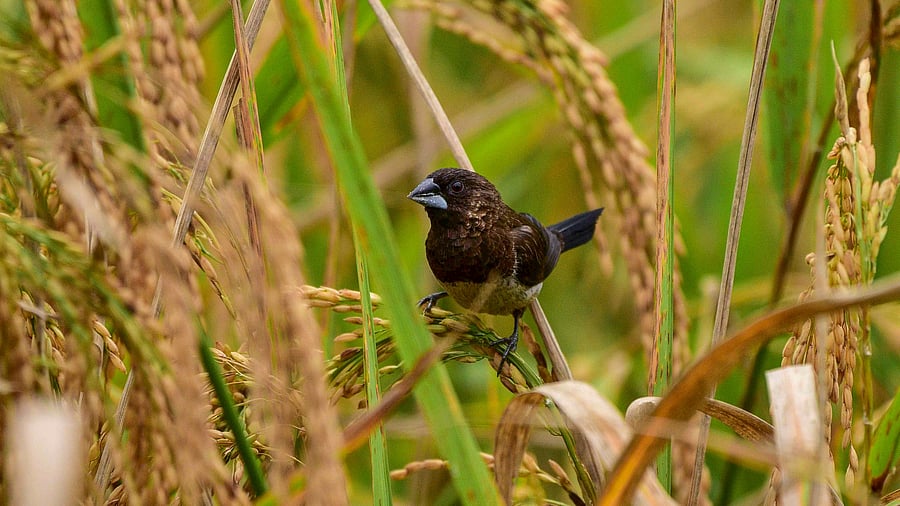
A munia bird eats rice in a paddy field.
Credit: PTI Photo
Hello, Abby. Something mysterious has happened. I am scared,” said Iddi on the phone. Hearing his older sister say this worried Abby deeply. While he was away at the hostel and Amma-Papa were away on a trip, Iddi was living alone at home in Bengaluru. “What happened?” he asked with concern.
“Well, I came home and found a pile of grass accumulated on the granite shelf in the balcony. I am not sure how it got there. We have completely secured the balcony, so nothing could get in. I also keep the door locked at all times. Maybe something supernatural is at play,” rambled Iddi. “Iddi... Iddi. Calm down. And seriously supernatural? You have been watching far too many supernatural and horror shows. You are studying to become a scientist! Don’t worry so much that you forget to reason. Why don’t we apply your training and use the scientific method to solve this mystery?” suggested Abby.
“Ok, sure,” said Iddi, still quite shaken.
“You had taught me all this and are forgetting it now. No problem, let us go step by step. First, a question based on the observations so far. How did the grass end up in the balcony? When did you notice it? Is there something you changed about the balcony?” asked Abby. “This will help us hypothesise,” he added.
“Firstly, it’s been raining. Super windy too, so maybe the grass flew in? Maybe someone who lives on the top floor cut the grass and it flew down?” he suggested.
“Yes, but how did the grass land so neatly cut on the shelf and also on the clothesline? Maybe it was a small bird? The net blocks pigeons, but I think a smaller bird might be able to make its way inside?” hypothesised Iddi. “To answer your earlier questions, I only noticed the grass today.I haven’t used the balcony since last night. So if anything mysterious has happened, it’s happened within this time frame,” she added.
“Why couldn’t it be a pigeon?” Abby asked. “Maybe the net has a loose spot? Remember how that pigeon got in through the net at Ajji’s house?” he questioned.
“Anyway, now that we have the hypotheses, should we do some tests and note down observations? That would help us solve the mystery,” said Abby.
“Okay. For the first test, I will check the net, if it has any loose ends. If it doesn’t, that eliminates the pigeon angle,” said Iddi. “Second, let me just throw these patches of grass and check if they reappear. I will also keep a close watch on the balcony,” she added.
“Good. Now sleep peacefully and do the test in the morning. Good night,” said Abby. Iddi threw away the grass and went to sleep.
The next morning, Iddi woke up determined to solve the mystery. She put on her glasses and went straight to the balcony, to check the net. What she saw next was something she had hypothesised already. But she was still awestruck.
Flying in like sharp arrows ready to hit their target were a pair of scaly-breasted munias. They had a brown back, and a white front, which was decorated with a scaly pattern. These birds were bringing the patches of grass in. As soon as they sensed Iddi, they flew away abandoning the grass. Iddi’s hypothesis about small birds was correct. She heaved a sigh of relief. Arriving at a conclusion was the final step of the scientific method. In this case, the conclusion was that the munias were bringing in the grass. “It is the munias. They are bringing in the grass,” Iddi messaged Abby. “Oh, thank god. Looks like they love our house. You can finally breathe a sigh of relief!” he texted her back.
With the mystery solved, Iddi had a nice story to tell Amma-Papa and her friends. This incident piqued Iddi’s interest in scaly-breasted munias. She started reading ‘The Book of Indian Birds’ by Salim Ali to do some research on eBird, and started reaching out to her ornithologist contacts.
While researching, Iddi learned that the scaly-breasted munias were found all over India, except for places that were extremely dry and cold. Both male and female munias looked alike, with slight differences. On comparing the pictures of these birds in the book to what she had seen, Iddi found that these munias were flaunting their breeding colours. It was also the middle of their nesting season, which usually ran from July to October. Iddi looked up pictures of their nests. The nests weremade of grass, and were spherical in shape. She also read that these birds loved devouring small berries, grass seeds, and insects.
“Abby, I read up so much about scaly-breasted munias. They are so cool. They also believe in equality and share domestic duties. We humans have so much to learn from them,” said Iddi on call. “Yes. We should also learn determination and persistence from birds and nature in general,” remarked Abby.